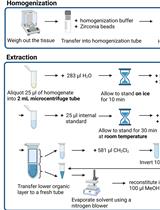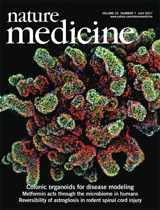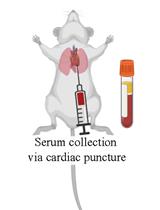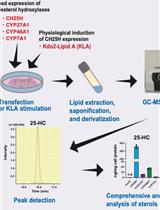- EN - English
- CN - 中文
Assessment of Uptake and Biodistribution of Radiolabeled Cholesterol in Mice Using Gavaged Recombinant Triglyceride-rich Lipoprotein Particles (rTRL)
使用管饲法重组富含甘油三酯的脂蛋白颗粒(rTRL)来评估小鼠中放射性标记的胆固醇的摄取和生物分布
发布: 2018年07月05日第8卷第13期 DOI: 10.21769/BioProtoc.2916 浏览次数: 5972
评审: Andrea PuharNelma Pértega-GomesTim Andrew Davies Smith

相关实验方案

使用多重反应监测(MRM)分析非酒精性脂肪性肝炎(NASH)小鼠肝匀浆中脂质分布的脂质组学工作流程
Hai Ning Wee [...] Jianhong Ching
2023年07月05日 2048 阅读
Abstract
The here described method can be used to estimate the uptake of orally provided cholesterol in mice. Briefly, mice are gavaged with radiolabeled cholesterol and 4 h later, organ distribution of the radiolabel is determined by liquid scintillation counting. The method has been applied successfully to determine dietary cholesterol handling of mice housed at different ambient temperatures
Keywords: Lipid metabolism (类脂物代谢作用)Background
Cholesterol facilitates membrane fluidity and is a precursor for steroid hormones, bile acids and vitamin D. Animals are provided with cholesterol either from the diet or by de novo synthesis. Surplus of cholesterol may be harmful as its accumulation in blood vessel walls can cause atherosclerosis. It has been shown that the activation of brown adipose tissue (BAT) by cold reduces hypercholesterolemia (Berbee et al., 2015). It was, however, unclear whether BAT activity alters acute peripheral dietary cholesterol handling. To address this question, we orally administered mice with recombinant triglyceride-rich lipoprotein particles (rTRL) labeled with [4-14C]-Cholesterol and measured the organ distribution of the radiolabel 4 h after gavage. The biodistribution of radiolabeled cholesterol in vivo has been measured before (Szigeti et al., 1972; Townsend et al., 2001). However, in these studies, the radioactive cholesterol was either supplied by the diet or injected intravenously. Furthermore, other studies have assessed the fractional cholesterol absorption rate over a longer period of time (48 and 72 h) (Zilversmit and Hughes, 1974; Turley et al., 1994), As we were especially interested in the plasma clearance and the cholesterol uptake into the BAT after cold exposure, we chose to analyze the organs after a rather short period of time (4 h). Instead of applying an oil gavage, we used rTRL since the oil gavage resembles a rather unphysiologic condition (very high amount of lipids) but not a postprandial situation. Additionally, supplying the tracer with the diet is not suitable in cold-treated mice as they eat twice as much as when kept at warm ambient temperatures (30 °C).
Materials and Reagents
- Pipette tips
- Glass Vials 50 x 14 mm with plastic srew cap 5 ml (schuett-biotec, catalog number: 3563143 )
- Eppendorf Safe-Lock Tubes (Eppendorf, catalog number: 022363352 )
- 15 ml Tube PP (SARSTEDT, catalog number: 62.554.502 )
- Pico Prias Vial 6 ml (PerkinElmer, catalog number: 6000193 )
- Parafilm (IDL, catalog number: 2801310131 )
- Omnifix-F Syringes 1 ml (B. Braun Medical, catalog number: 9161406V )
- Animal Feeding needles (Fine Science Tools, catalog number: 18061-20 )
- 100 Sterican Hypodermic needle (B. Braun Medical, catalog number: 4657519 )
- C57BL/6 Mice (Charles River)
- Intralipid® 20% (Baxter, catalog number: 2B6064 )
- Methanol (Carl Roth, ROTISOLV®, catalog number: 7583.1 )
- Chloroform (Carl Roth, ROTISOLV®, catalog number: 4432.1 )
- NaCl 0.9% (B. Braun Medical, catalog number: 817403 )
- Cholesterol, [4-14C]-, 50 µCi (1.85 MBq) (PerkinElmer, catalog number: NEC018050UC )
- EDTA solution (Sigma-Aldrich, catalog number: E7889-100ml )
- Solvable (PerkinElmer, catalog number: 6NE9100 )
- Ketamin 10% (WDT, catalog number: 793-319 )
- Rompun® 2% (Bayer)
- Lipid solution (see Recipes)
- Anesthesia (see Recipes)
Equipment
- Aquasafe 500 Plus (Gardner Denver Medical, ZINSSER ANALYTIC, model: Aquasafe 500 Plus, catalog number: 1008500 )
- Balance (Sartorius, catalog number: BP 410 S )
- Pipette (Eppendorf, model: Research® plus, catalog number: 3123000063 ) with tips
- HeraeusTM FrescoTM 21 Microcentrifuge, Max. RCF: 21,100 x g (Thermo Fisher Scientific, model: HeraeusTM FrescoTM 21 , catalog number: 75002555)
- Nitrogen-Stream from Nitrogen bottle (Flow rate 1.5 L/min)
- Sonifier (Branson, model: Digital Sonifier® 450 )
- Sonifier Horn Double Step 1/8'' Microtip (Branson, catalog number: 101-063-212 )
- Vortexer (IKA, model: MS 1 )
- Climate chamber (Memmert, model: HPP750life )
- Beta-Counter (PerkinElmer, model: Tri-Carb® 2810TR )
Procedure
文章信息
版权信息
© 2018 The Authors; exclusive licensee Bio-protocol LLC.
如何引用
Worthmann, A., John, C. and Heeren, J. (2018). Assessment of Uptake and Biodistribution of Radiolabeled Cholesterol in Mice Using Gavaged Recombinant Triglyceride-rich Lipoprotein Particles (rTRL). Bio-protocol 8(13): e2916. DOI: 10.21769/BioProtoc.2916.
分类
生物化学 > 脂质 > 脂质转运
生物化学 > 脂质 > 脂质测定
您对这篇实验方法有问题吗?
在此处发布您的问题,我们将邀请本文作者来回答。同时,我们会将您的问题发布到Bio-protocol Exchange,以便寻求社区成员的帮助。
提问指南
+ 问题描述
写下详细的问题描述,包括所有有助于他人回答您问题的信息(例如实验过程、条件和相关图像等)。
Share
Bluesky
X
Copy link











